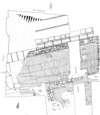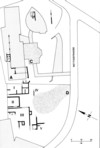The settlement began with the construction of a fort, shortly after the right bank of the Rhine's was conquered, c. 75 AD. At what date the town became civitas capital, is unclear, although the honorific ‘Aurelia’ might suggest a foundation by Marcus Aurelius (emperor 161-180 AD). The town's size and importance were heavily dependent on the exploitation of thermal springs, and inscriptions demonstrate that the spa which developed around them was frequented by soldiers from various units, including the legion stationed in Argentorate-Strasbourg.
Pottery finds suggest the presence of a Germanic settlement in the first half of the 1st century AD.
The fort lay on the Rettig hill, south of the thermal district and the ground
plans of barracks have been traced during excavations. Occupation began around
75 AD and may have ended before 84 AD, which is the date given by a building
inscription from what might be a later building.
 Plan
of Roman barracks on the Rettig hill
Plan
of Roman barracks on the Rettig hill
The Rettig and thermal district are the best known parts of the ancient town.
The distribution of finds suggests a settlement at least 600m long, but the
Roman town is not well enough understood to allow any statement concerning its
overall plan, or the design of its street grid.
 Extent
of the Roman settlement. A: Thermae district B: Rettig hill
Extent
of the Roman settlement. A: Thermae district B: Rettig hill
The hot spring area was occupied by several large thermae, which were closely linked to the site's role as a spa. The partially excavated Imperial Baths (Kaiserthermen) have so far yielded four large pools (at least 53m x 18m) and a hypocausted room. Its construction dates to the early 2nd century and an inscription recording a restoration dates to 213. Only a series of hypocausted rooms is known from the Military Baths (Soldatenbäder), but a further large bath complex is attested by a large building (K) between the other two.
Thermae district |
Model of the Imperial Baths |
Reconstructed ground plan of the Military Baths (Soldatenbäder) |
Part of a building excavated on the Florentiner Berg, in the immediate vicinity
of the Kaiserthermen, has been interpreted as part of a Gallo-Roman temple acting
as a sanctuary to the spring source. Parts of the area's rocky surface had to
be levelled during its construction and a concentration of stone dedications
suggests the presence of another sanctuary, near the modern Friedrichsbad.
 Roman
remains at the Florentinerberg
Roman
remains at the Florentinerberg
After the abandonment of the fort, the Rettig area was used by a sequence of
stone buildings, which were probably of a public or administrative nature. This
is particularly likely in the case of the incompletely known Bau I (width c.28m).
This has an apse and its construction has been linked to an inscription dated
to 84 AD.
 Stone
structures on the Rettig hill
Stone
structures on the Rettig hill
A building inscription mentions the guild house of the carpenters (schola fabrum tignariorum).
The town's residential structures remain largely unknown, although an area
containing several rooms, one of which seems to have contained a food shop,
has been excavated in the Gernsbacher Strasse.
 Roman stone remains in the Gernsbacher Strasse
Roman stone remains in the Gernsbacher Strasse
Visible remains
The military baths (Soldatenbäder) have been consolidated and can be visited.
Museum
Roman finds from Baden-Baden are on display in the Stadtmuseum.
Text: Thomas Schmidts
R.-H. Behrends, Ein römisches Gebäude am Florentinerberg in Baden-Baden. Fundberichte aus Baden-Württemberg 4, 1979, 143-151.
P. Knierriem/E. Löhnig/E. Schallmayer, Aquae, Baden-Baden. Die antike Bäderstadt im Lichte neuerer Ausgrabungen und Forschungen. Denkmalpflege in Baden-Württemberg 23/4, 1994, 139-147.
P. Mayer-Reppert/B. Rabold, Baden-Baden, Vorort der Civitas Aquae Aureliae. Brennpunkt "Soldatenbäder" - ein neu gestaltetes museales Kleinod für Kur- und Bäderstadt. Denkmalpflege in Baden-Württemberg 32/3, 2003, 235-244.
M. Riedel, Das römische Baden-Baden. Untersuchungen zur Siedlungsgeschichte. Fundberichte aus Baden-Württemberg 7, 1982, 273-300.
E. Schallmayer in: Die Römer in Baden-Württemberg (Stuttgart3 1986) 226-234.
E. Schallmayer, Aquae - das römische Baden-Baden. Führer zu archäologischen Denkmälern in Baden- Württemberg11 (Stuttgart 1989).
E. Schallmayer, Antike Thermen in der Kurstadt, Erhaltung, Erschliessung und Vermarktung römischer Bäder in Baden-Baden. Denkmalpflege in Baden-Württemberg 25/1, 1996, 70-78.
Reports on the excavations in Baden-Baden:
Archäologische Ausgrabungen in Baden-Württemberg 1989, 143-147; 1991,
139-145; 1992, 138-144; 1994, 117-124; 1995, 226-228; 1996 , 124-128; 1997,
128-130.